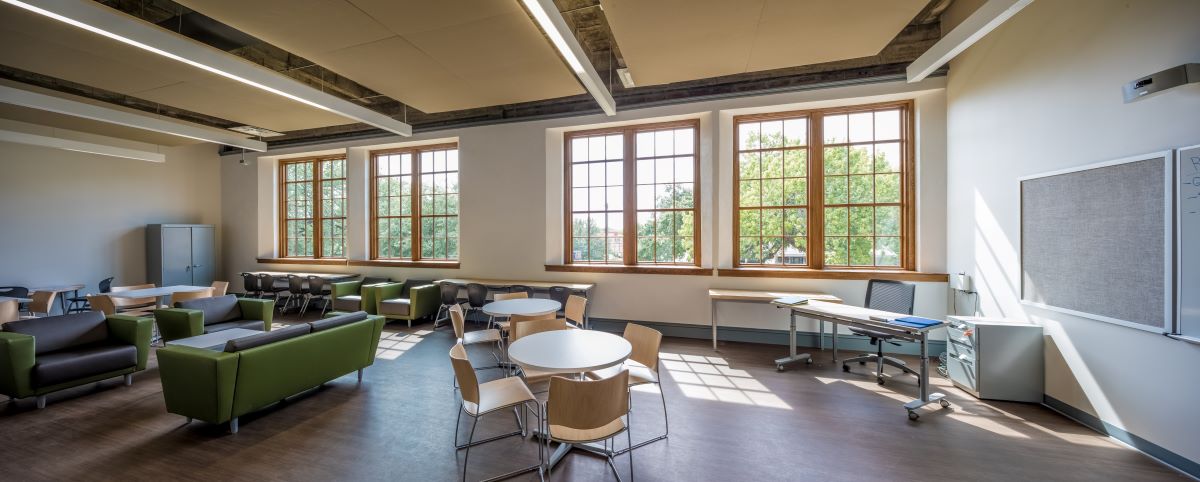By Zac Morton
The primary function of a school is to provide an optimum environment where teachers can communicate with students.
In fact, up to 60 percent of classroom activities involve oral communications between teachers and students or between students. Speech intelligibility is critical in schools.
But, very often, acoustic design is overlooked, and the result is a poor acoustical environment.
Common Acoustical Issues in Schools
Noise
Excessive ambient noise can cause distraction, fatigue, and low speech intelligibility. Noise in a space can come from a variety of sources:
- Equipment and student activities inside the room
- Equipment and student activities in other adjacent indoor or outdoor spaces due to insufficient sound isolation
- Noise and vibration travel through piping, ducts, and a building’s structure from other locations in the building
- Environmental noise (airplanes, trains, vehicles, etc.)
Reverberation
Excessive sound reverberation is common in spaces with mostly hard and reflective interior finishes (painted gypsum board, concrete/CMU, glazing, vinyl flooring, etc.).
Excessive reverberation causes echoes and low speech intelligibility (muffled sound). Spaces with large volumes tend to have greater sound reverberation issues.
Unique Acoustical Challenges and Opportunities in School Facility Design
Code Requirements
The 2021 International Building Code (IBC), already adopted by some schools, has added requirements to meet acoustical criteria in classrooms, including either reverberation time or noise reduction AND ambient sound levels.
Distance Learning/Streaming
Classrooms with audio equipment such as built-in or external microphones have more stringent requirements on the ambient noise level and sound reverberation time to function properly.
The ambient noise in the classroom can be picked up by the microphone, amplified, and transmitted to the remote party.
Most often, when an audio-conferencing system (Zoom, Teams, Skype, WebEx, etc.) has an echoic or muffled sound, the culprit is an improper acoustical environment (mostly hard and reflective interior finishes, excessive background noise from HVAC, etc.).
High Level of Activity Noise
Schools, especially K -12 classrooms, are some of the most densely populated spaces. Energetic students often raise their voices, fidget with items on the desktop, shuffle their feet, and unintentionally cause noises that can be disruptive.
Special Needs
Some students suffer from hearing impairments or cognitive and attention deficits, while other students speak English as a second language. For all these students, speech intelligibility is critical.
Reverberation times (RT) should not exceed 0.4 seconds in classrooms primarily used by hearing disabled students and 0.6 seconds in general classrooms.
Variety of Spaces
There are many different sizes of rooms in schools with different uses, which require different acoustical environments.
Classrooms, flexible and collaboration spaces, lecture halls, auditoriums, gymnasiums, band, and choir rooms, conference rooms, etc. each have different acoustical requirements for the rooms to function effectively.
Interior room finishes should be selected and designed based on the size and type of spaces to achieve optimum acoustical performance and accommodate the expected functionality of the space.
Green Building Certification
When pursued, minimum acoustical requirements must be met. Up to two LEED points can be achieved for enhanced acoustical performance. Acoustical analysis and calculations must be performed to provide the required documentation for LEED certification.
Acoustics consultation and design requires multi-disciplinary knowledge of the building systems, as well as an understanding of the design and construction process.
It also requires skills to balance all the program requirements (esthetics, budget, feasibility, efficiency.)
Achieving good acoustical performance is both an art and a science. One must strike the right balance to reach optimum performance while meeting a project’s budget.
For instance, it’s normally desired to have low ambient noise in a teaching space, but ambient noise levels that are too low could cause activity noises from outside of the room to be clearly audible and distractive.
In such a case, sound masking may be introduced to improve speech privacy and reduce noise distraction. Excessive reverberation time can cause echoes or muddled sounds.
However, when the reverberation time is too low, people must speak louder to be heard due to a lack of reflected sound.
Acoustical problems encountered after a building is occupied can be costly to resolve and can have a negative impact on learning outcomes. Therefore, acoustics should be addressed during the design of a facility.
Zac Morton, PE, LEED AP, is partner and K-12 market leader at DBR, www.dbrinc.com. Founded in 1972, DBR has evolved into the premier MEP engineering firm in Texas, providing mechanical, electrical, and plumbing engineering services, as well as building commissioning, integrated technology, and security system consulting. This article was contributed in collaboration with Weifang Wang.





